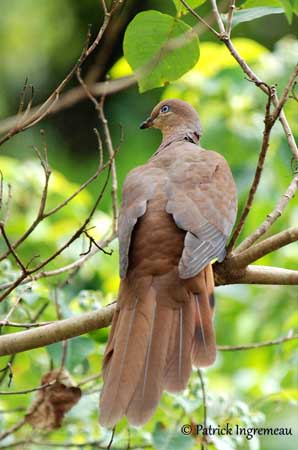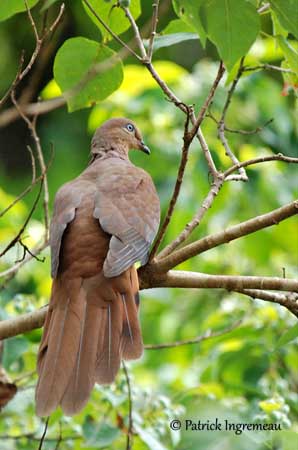
DIET:
The Brown Cuckoo-Dove feeds mainly on fruits, berries and seeds from several plant species. This genus has a muscular gizzard which allows the bird to digest very hard seeds.
It forages in low bushes and understorey, and also shrubby weeds.
PROTECTION / THREATS / STATUS:
The Brown Cuckoo-Dove is relatively common where patches of rainforest remain, but this species is able to adapt to secondary forest and habitat fragmentation.
Populations are stable and secure, and not currently threatened.
Fr: Phasianelle brune
All : Maronentaube
Esp: Tórtola-cuco Parda
Ital : Colomba fagiano
Nd: Australische Koekoeksduif
Sd: Röd gökduva
Photographers:
Patrick Ingremeau
TAMANDUA
Tom Merigan
Tom Merigan’s Photo Galleries
Text by Nicole Bouglouan
Sources:
HANDBOOK OF THE BIRDS OF THE WORLD vol 4 by Josep del Hoyo-Andrew Elliott-Jordi Sargatal - Lynx Edicions - ISBN: 8487334229
PIGEONS AND DOVES by David Gibbs, Eustace Barnes and John Cox - Pica Press Sussex - ISBN: 1873403607
Birds in backyards (Birds Australia and Australian Museum)
Wikipedia, the free encyclopaedia
Brown Cuckoo-Dove
Macropygia phasianella
Columbiforme Order – Columbidae Family
BIOMETRICS:
Length: 39-45 cm
Weight: 150-240 g
DESCRIPTION:
The Brown Cuckoo-Dove has long, graduated tail, often used for balance while the bird hangs from the branches to reach the food.
The adult male has dark grey hindneck and upper mantle, sometimes with purple or green iridescence according to the light. Rest of upperparts is dark brown. We can see narrow rufous fringes to scapulars and tertial feathers. The very long tail is graduated, with dark brown central rectrices and rufous outer feathers with black subterminal band.
Underparts are rufous-brown with cream-coloured chin and buff throat. The breast is orangey-brown with slight barred effect. The belly is yellowish-rufous, shading to bright chestnut on undertail-coverts, flanks and underwing-coverts.
The head is rufous-brown with greyer crown and nape.
The bill is grey-black. The eyes are pale blue, surrounded by blue-grey bare skin. Legs and feet are pinkish-red.

The adult female has almost similar plumage, but she has bright chestnut head and conspicuous brown barring to neck sides and breast. She lacks the iridescence above.
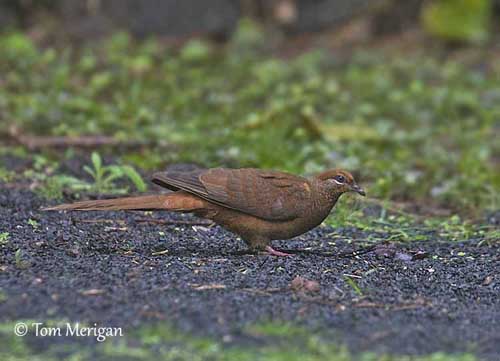
The juvenile resembles female with more chestnut head and black speckling, buff cheeks and ear-coverts with fine dark barring. The upperparts show broader and brighter rufous fringes. Mantle, neck and breast show conspicuous blackish barring. The bill is duller, mostly grey-brown.
VOICE: SOUNDS BY XENO-CANTO
The Brown Cuckoo-Dove’s advertising call is a clear “oo-wup”, more trisyllabic at close range “coo-oo-up” with longer and rising last note. But at a distance, only the last “whoop” can be heard. This call is often repeated several times.
During the displays, the call is similar but with harsher tonality.
HABITAT:
The Brown Cuckoo-Dove frequents the rainforest, the edges and understorey along streams, clearings, secondary growths and roadsides. It can be seen in the adjacent farmlands and areas with bushes and fruiting trees.
RANGE:
The Brown Cuckoo-Dove is found in coastal regions and adjacent highlands of E Australia, from tip of Cape York Peninsula to E Victoria.
This species seems to be locally nomadic according to the food resources, but it is usually present all year round.
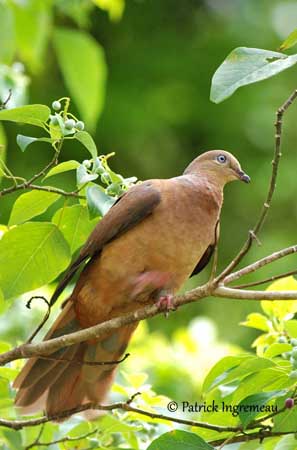
BEHAVIOUR:
The Brown Cuckoo-Dove is often seen in pairs of small groups. It forages in the lower canopy, undergrowth and edges. This species feeds mainly on fruits and seeds of numerous plant species, usually fleshy fruits, seeds, smaller fruits and berries.
Unlike other fruit-pigeons, this bird is able to digest hard seeds, and it is known to take gravels to help the digestion.
The Brown Cuckoo-Dove is very active when feeding, and uses the long tail for balance during some acrobatic manoeuvres to reach the food.
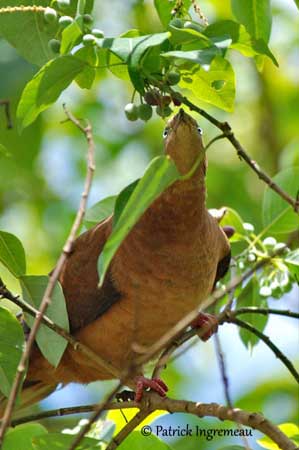
This species probably breeds all year round, with a peak between July and December.
The male performs frequent flights displays. It displays at forest edge or in a clearing, flying up with partly spread tail and wing clapping loudly. Just above the trees, at the flight top, the tail is fanned wide, the wings are held in a downwards curve, and the male glides back to the perch, following a semi-circular path.
Then, it performs bowing displays in bouts of 3 to 5 in front of the female. The bill is pulled towards the breast while it bows until its body is in a horizontal position, with closed tail. Breast and neck are inflated, and a distinctive call can be heard. And then, the body is slowly raised to upright stance.
This is the characteristic display of numerous Columbidae species.
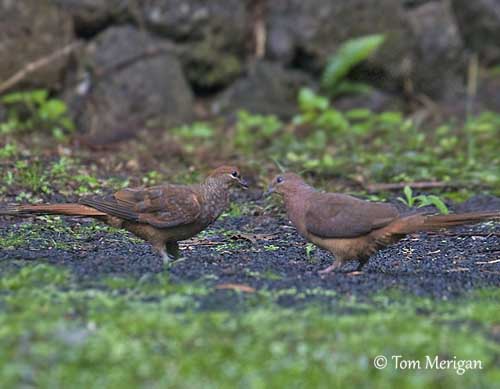
FLIGHT:
The Brown Cuckoo-Dove performs direct and strong flight with slow wingbeats.
REPRODUCTION:
The breeding season is extended.
The Brown Cuckoo-Dove’s nest is a small platform made with dry sticks, which may be flimsy or substantial. It is placed at about 1-5 metres above the ground in low tree or bush, or even vine-tangles.
The female lays 1-2 glossy white eggs. Both parents incubate during 16-18 days. The chicks are covered with long, thick, yellow down. They are fed by the adults, and fledge about 14-17 days after hatching.
